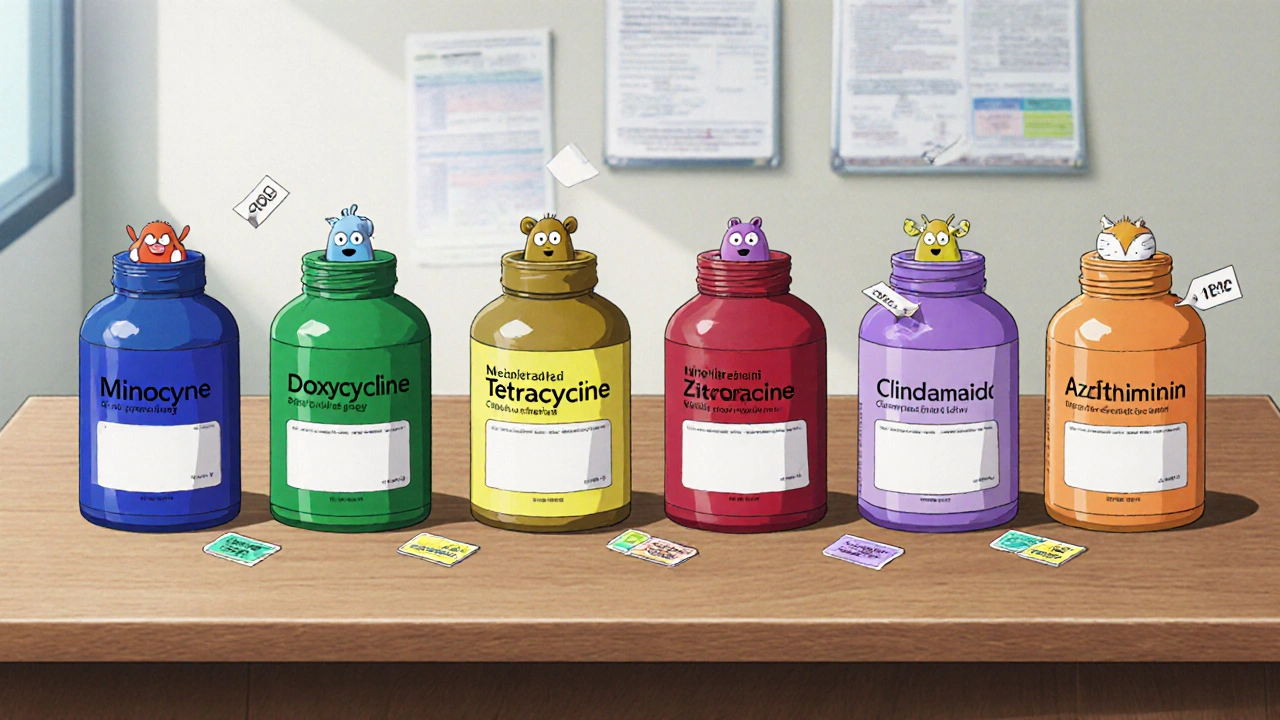Antibiotic Selection Tool
Find Your Best Antibiotic Match
You're trying to decide whether Minocycline is the right choice for your skin or infection problem, but you keep hearing about other antibiotics. This guide breaks down Minocycline (branded as Minomycin) and lines it up against the most common alternatives, so you can see which drug fits your condition, budget, and tolerance level.
What is Minocycline (Minomycin)?
Minocycline is a broad‑spectrum tetracycline‑class antibiotic that works by inhibiting bacterial protein synthesis. Approved in the US in 1971, it’s usually prescribed for moderate to severe acne, rosacea, and a handful of systemic infections such as Rheumatoid arthritis flares and certain respiratory tract infections.
Typical adult dosing for acne is 100mg orally once or twice daily. The drug’s half‑life is 12‑16hours, allowing convenient once‑daily schedules for many patients. Because it’s more lipophilic than other tetracyclines, Minocycline penetrates skin and joint tissue well, which explains its popularity among dermatologists.
Side‑effects to watch for include dizziness, nausea, photosensitivity, and, in rare cases, drug‑induced lupus. It’s contraindicated in pregnancy, children under eight, and patients with severe hepatic impairment.
Why Look at Alternatives?
Even though Minocycline packs a punch, it isn’t the best fit for everyone. Some patients experience intolerable stomach upset, while others worry about the higher price tag compared with generic tetracyclines. Antibiotic resistance patterns also shift over time, making a different drug a smarter choice for certain infections.
Below are the most frequently mentioned substitutes, each with its own strengths and trade‑offs.
Side‑by‑Side Comparison Table
| Antibiotic | Class | Typical Oral Dose | Primary Indications | Common Side‑effects | Cost (US$ per 30‑day supply) |
|---|---|---|---|---|---|
| Minocycline | Tetracycline | 100mg 1-2×/day | Acne, rosacea, certain respiratory infections | Dizziness, photosensitivity, nausea | ~$30‑$45 |
| Doxycycline | Tetracycline | 100mg 1×/day | Acne, Lyme disease, travel‑related diarrhea | Esophageal irritation, photosensitivity | ~$10‑$20 |
| Tetracycline | Tetracycline | 250‑500mg 4×/day | Acne, chlamydial infections | GI upset, hepatotoxicity (rare) | ~$8‑$15 |
| Azithromycin | Macrolide | 500mg 1×/day (5‑day course) | Respiratory infections, STIs, skin infections | Diarrhea, QT prolongation | ~$25‑$35 |
| Clindamycin | Lincosamide | 300mg 3-4×/day | Severe acne, MRSA skin infections | Clostridioides difficile colitis | ~$30‑$50 |
| Amoxicillin | Penicillin | 500mg 3×/day | Sinusitis, otitis media, urinary tract infections | Rash, GI upset | ~$12‑$18 |
Doxycycline - The Close Cousin
Doxycycline shares the same tetracycline backbone but is more water‑soluble, which means it causes fewer stomach complaints. Many dermatologists start patients on doxycycline for mild‑to‑moderate acne because the daily dose (100mg) is simple and the price is low. Its long half‑life (≈18hours) also makes once‑daily dosing reliable.
Where doxycycline falls short is in treating deep‑seated infections; it doesn’t achieve the same tissue concentrations in joints as Minocycline. If you have rosacea‑related ocular symptoms, Minocycline may still be the better pick.

Tetracycline - The Old‑School Option
Generic Tetracycline was the original drug that spawned the whole class. It’s effective but requires a four‑times‑daily schedule and is notorious for hepatotoxicity at high doses. Because of the inconvenient dosing, most clinicians reserve it for patients who can’t afford newer agents or who have specific bacterial sensitivities.
Side‑effects like nausea and vomiting are common, and the drug can cause discoloration of teeth in children-hence the age restriction.
Azithromycin - A Macrolide Alternative
Azithromycin works by blocking bacterial protein synthesis, yet it belongs to a different class (macrolide). Its appeal lies in the short, five‑day course and a relatively mild side‑effect profile. For patients who can’t tolerate tetracyclines because of photosensitivity or pregnancy, azithromycin becomes a go‑to for skin infections and certain respiratory bugs.
However, azithromycin isn’t as effective against the Propionibacterium acnes strains that drive most acne. Moreover, recent studies suggest a modest increase in cardiac arrhythmia risk when combined with other QT‑prolonging drugs.
Clindamycin - The Heavy‑Duty Lincosamide
When acne is severe or when there is a suspicion of methicillin‑resistant Staphylococcus aureus (MRSA), Clindamycin is often prescribed. It penetrates skin well and can be taken orally or applied topically.
The big drawback is the risk of Clostridioides difficile infection, which can turn a simple acne flare into a serious gastrointestinal emergency. Because of this, clinicians reserve clindamycin for short‑term bursts rather than long‑term acne management.
Amoxicillin - The Penicillin Workhorse
Amoxicillin isn’t a tetracycline, but its broad spectrum and low cost make it a frequent alternative for patients with uncomplicated skin or respiratory infections. It’s safe in pregnancy and children over six months, which is a clear advantage over Minocycline.
Unfortunately, amoxicillin lacks the anti‑inflammatory properties that help clear acne lesions, so it’s rarely the first pick for dermatological use.

How to Choose the Right Antibiotic
- Infection type: For acne and rosacea, stay within the tetracycline family (Minocycline or Doxycycline). For acute bacterial skin infections, consider Clindamycin or Azithromycin.
- Patient age & pregnancy status: Minocycline is off‑limits for pregnant women and kids under eight. Azithromycin and Amoxicillin become the safer bets.
- Side‑effect tolerance: If photosensitivity is a deal‑breaker, Doxycycline or Azithromycin may be gentler.
- Resistance patterns: Local antibiograms (lab‑generated resistance maps) often show rising resistance to classic tetracyclines in community‑acquired infections. Ask your provider for the latest data.
- Cost considerations: Generic Tetracycline and Doxycycline are the cheapest, while Minocycline and Clindamycin sit at the higher end of the price spectrum.
Practical Tips for Safe Use
- Take the pill with a full glass of water; avoid lying down for at least 30minutes to prevent esophageal irritation.
- Pair the medication with a calcium‑rich meal or a dairy supplement only if the drug label permits; many tetracyclines bind calcium and lose effectiveness.
- Use sunscreen daily. Even a light SPF can cut down the risk of severe sunburn caused by photosensitivity.
- Complete the prescribed course, even if skin looks clear after a week. Stopping early fuels resistance.
- Report any unusual rash, persistent diarrhea, or joint pain to your clinician promptly; these could signal a serious adverse reaction.
Bottom Line
If you need a potent, skin‑penetrating antibiotic and can afford a modest price, Minocycline remains a top choice, especially for stubborn acne or rosacea. When cost, pregnancy, or side‑effect profile tip the scales, Doxycycline, Azithromycin, or Amoxicillin offer viable workarounds. Always let your healthcare provider weigh infection severity, personal health factors, and local resistance trends before settling on a drug.
Frequently Asked Questions
Can I use Minocycline for a bacterial throat infection?
Minocycline isn’t the first‑line treatment for streptococcal pharyngitis. Doctors usually favor penicillins or cephalosporins because they target the common streptococcus species more directly and have a lower risk of side‑effects.
Is Minocycline safe during breastfeeding?
Minocycline passes into breast milk in small amounts. Most pediatric guidelines advise against its use while nursing, recommending safer options like erythromycin if an antibiotic is absolutely needed.
Why does Minocycline cause a blue-gray discoloration of the skin?
Long‑term use can lead to deposition of pigmented metabolites in the skin, especially on the shins and forearms. This side‑effect is rare but documented; stopping the drug usually prevents further darkening.
How does antibiotic resistance affect my choice?
If local labs report high resistance rates to tetracyclines for your infection type, doctors may skip Minocycline in favor of a macrolide or a beta‑lactam that still shows activity. Ask your clinician for the most recent antibiogram.
Can I combine Minocycline with topical acne treatments?
Yes. In fact, many dermatologists pair oral Minocycline with benzoyl peroxide or retinoids to attack acne from both inside and out. Just watch for increased skin irritation; start with a lower concentration of the topical.

